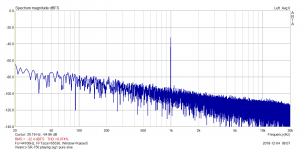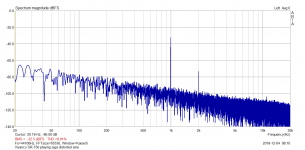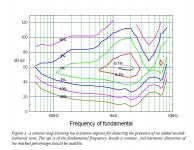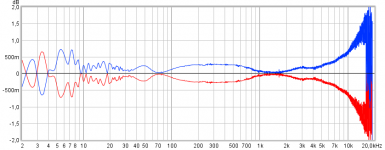so now i want to find something worse than my computer speakers to see if i can score higher...
I wondered about that too, as I remember the same thing. That's why I tried it with laptop speakers - no luck. I also wondered of ScottJoplin is able to hear it because of the Grados. The Grado headphones are known for a peaky response in the midrange. Could that push up the 2nd harmonic? I can't stand Grados - like hot pokers in my ears. But many people love them. Different ears.Quite often I had a feedback of listeners who used the cheapest equipment and reporting dramatic sound differences.
I think there are at least a couple of mechanism at work here, level of THD and phase of 2H that may affect perception of difference.Your thoughts on this?
Recorded musical piece like apricot is complex and already contain some distortion with unknown level and phase. When the original material is passed through a mu follower, some known ~0.5% THD and negative 90 deg 2H phase is added. However the sum level or phase of distortion remains unknown. Then a phase inversion through the ADC is applied which has no effect on the level of the distortion sum but will alter phase of 2H distortion 180 deg of the then recorded signal.
A point that you may find interesting to explore further, threshold of detection of difference may be altered if the original material is inverted (I think an inverter plugin is available for foobar) before the mu follower stage, and then recorded with no phase inversion by the ADC to produce a different sum of distortion level and phase of 2H.
Once again to the test with sine waves (sig1, siga), I think the key factor is if the headphones or speakers used are able to reproduce "clean" signal, i.e. their distortion. I am checking this on acoustical side, with a measuring microphone, and as one can see the headphones I use (Vivanco SR-750) are able to distinguish the two test tones and have distortion low enough. This, together with a proper volume level (quite low), is a key to a successful DBT result.
Attachments
Then a phase inversion through the ADC is applied which has no effect on the level of the distortion sum but will alter phase of 2H distortion 180 deg of the then recorded signal.
I do not understand why ADC would introduce a phase inversion? The apricot/avocado files are recorded with a correct phase, with no phase inversion. Yes distortion components have a phase, such is life, but the only relevant distortion component here is H2, coming from a simple polynomial nonlinearity, so with known and predictable (and measured) phase, all other components inaudible. REW software measures phase of distortion components.
The Grado headphones are known for a peaky response in the midrange. Could that push up the 2nd harmonic? I can't stand Grados - like hot pokers in my ears. But many people love them. Different ears.
It may change it a bit by its own distortion, because every electroacoustic transducer has some (and not very low) distortion. That's why I assume the system should be verified by measurement. However, using higher distortion transducers adds distortion to the pure sine and makes sig1 indistinguishable from siga. I tried the test with laptop speakers ant there is no chance - even a pure sine sounds distorted.
My point when speaking about reported "big differences" on a very poor equipment was that it does nothing correct, and a small change in a complex signal reflects in unpredictable output on acoustical side.
Last edited:
It's 0.64% THD, whilst I can easily hear it with the sine
Glad to hear this.
Again to sine tone distortion audibility, one of the best plots on the subject is IMO in
J. ROBERT STUART: Coding High Quality Digital Audio
The plot addresses frequency, SPL and H2 audibility threshold. According to that plot, our distorted sine should be distinguishable between about 50 - 80 dB SPL.
J. ROBERT STUART: Coding High Quality Digital Audio
The plot addresses frequency, SPL and H2 audibility threshold. According to that plot, our distorted sine should be distinguishable between about 50 - 80 dB SPL.
Attachments
I do not understand why ADC would introduce a phase inversion? The apricot/avocado files are recorded with a correct phase, with no phase inversion. Yes distortion components have a phase, such is life, but the only relevant distortion component here is H2, coming from a simple polynomial nonlinearity, so with known and predictable (and measured) phase, all other components inaudible. REW software measures phase of distortion components.
Maybe I misunderstand?Hello indra1, thank you for your question. Both files have the same phase (and are time aligned, except for small time shift in microseconds in the amp channel). A/D input is balanced, so I made the phase inversion for the amp recording just by swapping +IN and -IN wires at the input XLR connector.
i listened to the sine files again (still can't hear a difference) they simply sound like distorted sine waves, and trust me i use an old school Eico sine generator to do service and know what a clean low distortion sine wave sounds like (i won't rant about about my take on ADC DAC) but those files seem way more distorted then the reported percentage!
as far as the differences in the fruit files i'll share after the reveal!
as far as the differences in the fruit files i'll share after the reveal!
Conclusion
The poll has just expired . I would like to thank everyone who participated in the test, sent a vote, published the ABX report or wrote comments on sound of the files.
The poll results after closing:
Apricot is the original file 7
Avocado is the original file 5
I prefer Apricot by listening 7
I prefer Avocado by listening 7
Multiple Choice Poll. Voters: 15.
The votes have been distributed quite equally between the test files, so it is difficult to tell if there was any general preference.
Disclosure:
Apricot is the file that was recorded through the open-loop hybrid tube-SS power amplifier, with transistor class A unity gain output stage.
Avocado is the original CD rip.
We have collected 10 ABX reports (I apologize if I have missed some). The results are from 4/10 to 11/16, however we have two 9/16 records and three 10/16 records which indicates, to me, that the sound difference might have been just above the border of detectability, but we cannot say it for sure.
ABX report results:
4/10 (82.8% probability of guessing) … 1x
6/10 (37.7% probability of guessing) … 1x
7/16 (77.3% probability of guessing) … 1x
8/15 (50% probability of guessing) … 1x
9/16 (40.2% probability of guessing) … 2x
10/16 (22.7% probability of guessing) … 3x
11/16 (10.5% probability of guessing) … 1x
The results indicate that the sound difference between the test files was not very big (= not easily detectable in a DBT), but might have been detectable for some participants.
The hybrid amplifier was chosen for this test for two reasons:
tube gain stage has “typical” distortion profile with decaying amplitude of harmonic components and only the 2nd (and 3rd questionably) harmonic is above possible audibility threshold on pure tones,
class A transistor power buffer is free of cross-over distortion and has very low distortion in absolute terms, below 0.001%. Its output impedance is fairly low 0.23 ohm, which should be low enough not to modulate frequency response by the speakers connected.
It seems that distortion of the amp under test, which was H2 up to about 0.7% for the test file amplitudes, is not easy to tell by ear on the music samples used. In my opinion, the so called “tube sound” is not the result of just non-linear distortion, but rather of the high output impedance of tube power amplifiers in combination with often not very good S/N ratio. That's why I have used the class A solid state output stage, to avoid high output impedance influence, and why I tried to achieve the highest possible clean dynamic range of the amplifier. The goal was to concentrate on distortion itself.
The poll has just expired . I would like to thank everyone who participated in the test, sent a vote, published the ABX report or wrote comments on sound of the files.
The poll results after closing:
Apricot is the original file 7
Avocado is the original file 5
I prefer Apricot by listening 7
I prefer Avocado by listening 7
Multiple Choice Poll. Voters: 15.
The votes have been distributed quite equally between the test files, so it is difficult to tell if there was any general preference.
Disclosure:
Apricot is the file that was recorded through the open-loop hybrid tube-SS power amplifier, with transistor class A unity gain output stage.
Avocado is the original CD rip.
We have collected 10 ABX reports (I apologize if I have missed some). The results are from 4/10 to 11/16, however we have two 9/16 records and three 10/16 records which indicates, to me, that the sound difference might have been just above the border of detectability, but we cannot say it for sure.
ABX report results:
4/10 (82.8% probability of guessing) … 1x
6/10 (37.7% probability of guessing) … 1x
7/16 (77.3% probability of guessing) … 1x
8/15 (50% probability of guessing) … 1x
9/16 (40.2% probability of guessing) … 2x
10/16 (22.7% probability of guessing) … 3x
11/16 (10.5% probability of guessing) … 1x
The results indicate that the sound difference between the test files was not very big (= not easily detectable in a DBT), but might have been detectable for some participants.
The hybrid amplifier was chosen for this test for two reasons:
tube gain stage has “typical” distortion profile with decaying amplitude of harmonic components and only the 2nd (and 3rd questionably) harmonic is above possible audibility threshold on pure tones,
class A transistor power buffer is free of cross-over distortion and has very low distortion in absolute terms, below 0.001%. Its output impedance is fairly low 0.23 ohm, which should be low enough not to modulate frequency response by the speakers connected.
It seems that distortion of the amp under test, which was H2 up to about 0.7% for the test file amplitudes, is not easy to tell by ear on the music samples used. In my opinion, the so called “tube sound” is not the result of just non-linear distortion, but rather of the high output impedance of tube power amplifiers in combination with often not very good S/N ratio. That's why I have used the class A solid state output stage, to avoid high output impedance influence, and why I tried to achieve the highest possible clean dynamic range of the amplifier. The goal was to concentrate on distortion itself.
Many of those who mentioned the bass expressed a preference for Apricot, it seems likely the added distortion here resulted in a less "muddy" sound
Thank you Pavel, these listening tests are always illuminating.
I really couldn't differentiate them using Foobar and headphones but reported that I felt I preferred Avocado (which surprised me because I usually go for the most coloured). Maybe it was a lucky guess 😉
And thanks again, I know just how much effort goes into preparing files like these and running/collating poll results.
I really couldn't differentiate them using Foobar and headphones but reported that I felt I preferred Avocado (which surprised me because I usually go for the most coloured). Maybe it was a lucky guess 😉
And thanks again, I know just how much effort goes into preparing files like these and running/collating poll results.
Thanks for your kind words, Karl. Though I can reliably tell the difference between the pure test sine and the distorted one, I think I also cannot tell the same thing about the music files apricot/avocado, with my results 9/16 and 11/16. It might be a slight indication, but definitely not the proof of ability to tell the difference between the files.
I think that after "childhood diseases" of our listening tests several years ago we have learned how to prepare technically valid test, regarding level equalization and time alignment. And, too avoid signal-less (noise only) parts of the music samples.
I think now it is your turn, so if you have a good idea, I will be glad to participate in your next test 😉.
I think that after "childhood diseases" of our listening tests several years ago we have learned how to prepare technically valid test, regarding level equalization and time alignment. And, too avoid signal-less (noise only) parts of the music samples.
I think now it is your turn, so if you have a good idea, I will be glad to participate in your next test 😉.
Many of those who mentioned the bass expressed a preference for Apricot, it seems likely the added distortion here resulted in a less "muddy" sound
In fact, it is quite difficult to tell the distortion of the low frequency tone (see the audibility threshold graph posted few hours earlier). Maybe a slight change in harmonics leads to a subjective difference in bass perception.
i was certain that Avacado was the processed signal because it contains a "warmth" in the lower frequencies and added depth to the reverb spectra in the recording, but with Apricot being the processed file how is it that it subjectively seems smaller/colder? is the distortion messing with DA processes in my soundcard? that would explain why i was not able to differentiate the sine files!?
Calculating the probability for the combined results, under the assumption that the null-hypothesis is true, gives:
P(X >=84 l 147) = 0.0494
That means, the probability to get 84 hits in 147 trials by random guessing is 4,94% .
P(X >=84 l 147) = 0.0494
That means, the probability to get 84 hits in 147 trials by random guessing is 4,94% .
Calculating the probability for the combined results, under the assumption that the null-hypothesis is true, gives:
P(X >=84 l 147) = 0.0494
That means, the probability to get 84 hits in 147 trials by random guessing is 4,94% .
Yes.
Cumulative probability:
P(X > x) 0.04935036366
We have the same maths.
I am not an expert on test procedures, so is it possible to take results of 8 different people and make a simple sum of trials, to get the final probability of guessing?
Thanks your work and sharings PMA, myself then prefer your good builded tube amp : ) but couldn't differiantate them in ABX test.
Think down the road i became aware my preference was the tube amp, it was at the time where Max Headroom made some noice i decided lookup spectrum plot for those two fruit files into Audacity and import spectrum into REW for making overlays and in that frq response for tube amp was shared in post 20 being about -2dB down at 20kHz it looked clear which fruit was tube amp, below graphs was using REW to divide their spectrum with each other and the red one makes most sence so that avocado is the neutral reference file.
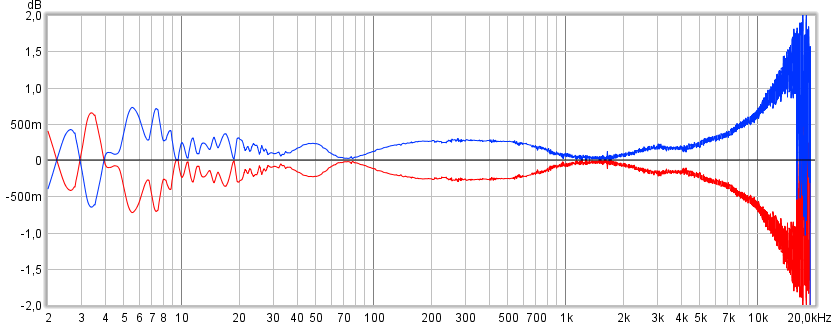
Think down the road i became aware my preference was the tube amp, it was at the time where Max Headroom made some noice i decided lookup spectrum plot for those two fruit files into Audacity and import spectrum into REW for making overlays and in that frq response for tube amp was shared in post 20 being about -2dB down at 20kHz it looked clear which fruit was tube amp, below graphs was using REW to divide their spectrum with each other and the red one makes most sence so that avocado is the neutral reference file.
Attachments
Last edited:
- Home
- General Interest
- Everything Else
- Can you tell original file from tube amp record? - test
